How Long Do Petunias Last? A Guide to Their Lifespan
If you’re a fan of vibrant gardens, you might have wondered about the lifespan of petunias. These beautiful blooms are popular for their bright colors and lush display. Petunias are often treated as annuals, typically surviving one growing season, but they can actually last 2-3 years if they are tended to as tender perennials.
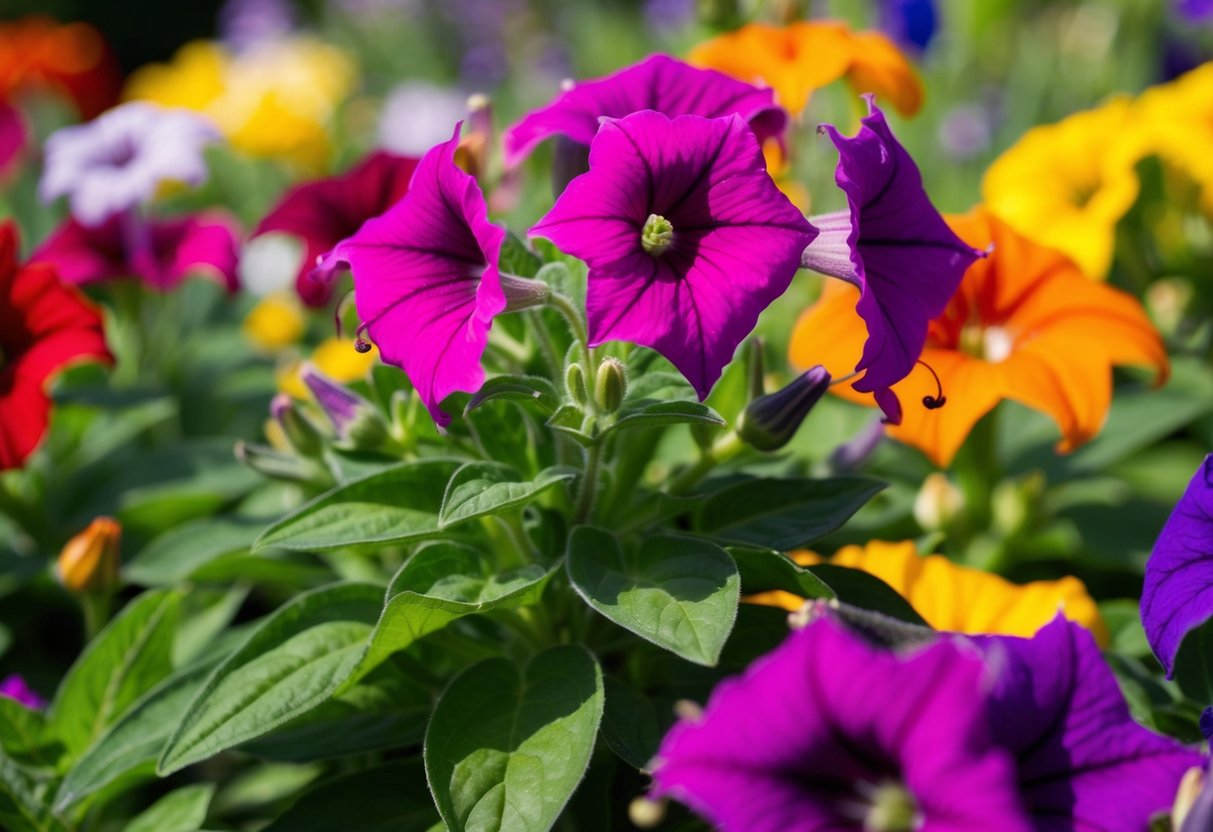
To make your petunias thrive, you’ll need to provide them with at least 6-8 hours of sunlight each day. This is essential for their health and flowering.
With proper care, including regular watering and well-drained soil, you’ll enjoy these stunning flowers for as long as possible.
Whether you plant them in gardens or containers, the right environment can extend their beauty. If you’re using containers, make sure to choose a mix that will drain well, as this helps keep the roots healthy.
With a little love and attention, your petunias can flourish, providing you with a splash of color from spring to the first frost.
Understanding Petunias

Petunias are popular garden flowers known for their vibrant colors and ability to bloom throughout the growing season. There are many types, each with its own characteristics. Understanding their lifespan and whether they are annuals or perennials will help you care for them better.
Types of Petunias
Petunias come in several varieties with unique features. Grandiflora petunias have large, showy flowers and are perfect for display. Multiflora petunias are smaller, more resilient, and handle wet weather well. If you prefer compact blooms, milliflora petunias may be your choice.
Spreading petunias, including Wave and Supertunia, cover large areas and are excellent for ground cover. Most petunias you see in gardens are hybrids, offering a combination of traits from various types. Regardless of which you choose, understanding these varieties will guide you in selecting the right petunias for your garden.
Petunia Lifespan
Petunias have a varied lifespan depending on care and conditions. Typically, they last about 4 to 6 months, providing many colorful blooms during this time. Some species can live longer, up to 2-3 years, but they are generally treated as annuals.
To extend their life, provide plenty of sunlight, around 6 to 8 hours a day. Regular water and proper fertilization are key to maintaining their health and vibrant appearance.
Annual Versus Perennial Petunias
Most petunias are grown as annuals, completing their life cycle in one growing season. This includes popular spreading varieties like Wave petunias. In warmer climates, some petunias might survive and act like perennials, coming back year after year.
While true perennials exist within the petunia family, known botanically as Petunia spp, they’re less common in home gardens. When choosing petunias, consider your climate and whether you want to plant new flowers each year or hope for a repeat performance in the following season. Understanding these differences will help you decide what’s best for your garden needs.
Planting and Care
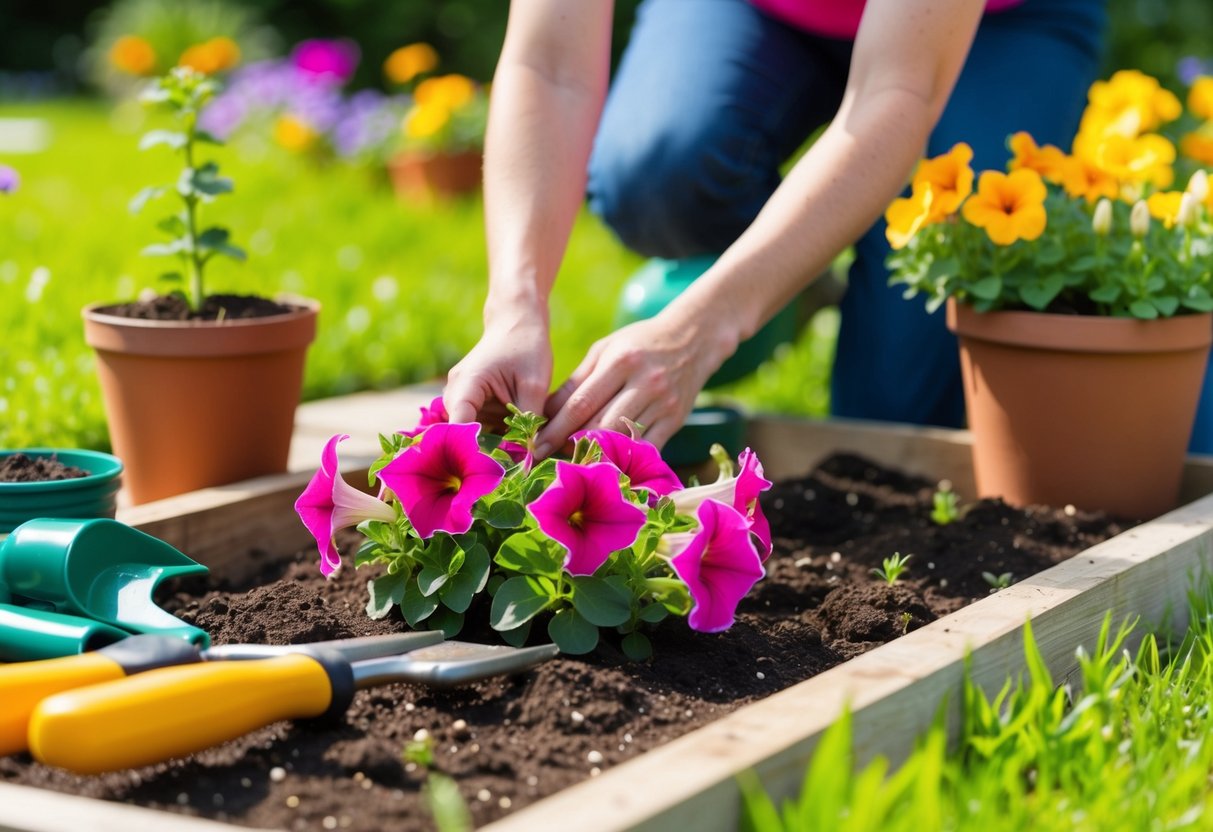
To grow petunias successfully, you should focus on selecting the right soil, providing proper watering, and using suitable fertilizing practices. Meeting these needs will ensure that your petunias thrive, offering beautiful blooms throughout their lifespan.
Soil and Planting
When planting petunias, choosing the right soil is crucial. Petunias prefer well-draining soil that prevents water from pooling around the roots. This helps avoid root rot and promotes healthy growth. A mix of garden soil with some compost can improve drainage and add nutrients.
Petunias thrive when planted in an area that receives full sunlight. This means at least six hours of direct sunlight each day.
Before planting, ensure the soil is loose by breaking up any clumps. Space the plants 12 to 18 inches apart to allow for proper air circulation, which reduces the risk of disease.
Watering Requirements
Watering your petunias correctly is essential for their health. While petunias need consistent moisture, it’s important not to overwater, as this can lead to root problems.
The key is to keep the soil consistently moist but not soggy.
A good practice is to water deeply once a week, allowing the water to reach the roots. During hotter months, you may need to water more frequently.
Checking the top inch of soil can help you determine if they need water. If it’s dry, it’s time to water.
Fertilizing Practices
Fertilizing petunias ensures they have the nutrients needed to produce vibrant blooms. Use a balanced fertilizer with equal parts nitrogen, phosphorus, and potassium. A 10-10-10 or 20-20-20 fertilizer is a good choice.
Apply fertilizer every two weeks during the growing season. You can use a slow-release granular fertilizer at planting or a liquid fertilizer for more immediate results.
Mulch can also be added to help retain moisture and reduce weed competition. This creates a conducive environment for petunias to flourish.
Common Growth Challenges
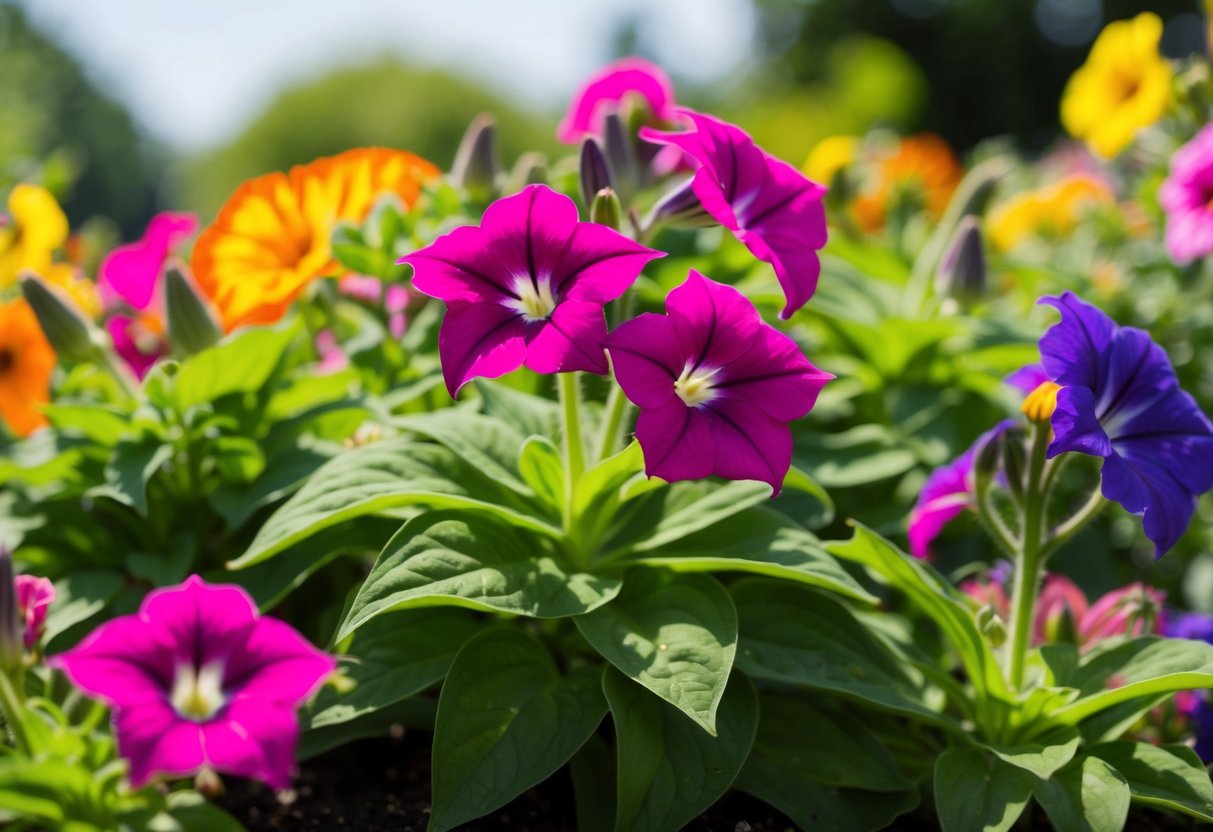
Petunias, while beautiful, can face a range of growth challenges. These include threats from pests and diseases, as well as the need for specific maintenance practices to ensure they thrive. Paying attention to these areas will help your petunias grow vibrant and healthy.
Dealing with Pests and Diseases
Petunias are often targeted by pests such as aphids and slugs. Aphids can cause damage by sucking the sap from the plant, leading to curled leaves and stunted growth. You can manage them by spraying the plants with insecticidal soap or introducing natural predators like ladybugs.
Slugs also pose a threat, often feeding on leaves and causing holes. A simple method to deter slugs is to sprinkle diatomaceous earth around the base of your plants. This acts as a barrier they won’t cross.
In addition to pests, petunias can be affected by diseases such as powdery mildew. This fungal infection appears as white powder on leaves and can hinder plant growth.
Ensure proper air circulation and avoid overhead watering to minimize risk. If the disease appears, treat with a fungicide or remove affected foliage.
Maintaining Optimal Growth
To keep your petunias thriving, proper maintenance is key. Regular deadheading, which involves removing spent blooms, encourages continuous blooming. This prevents seeds from forming and redirects energy back into producing new flowers.
Petunias are prone to becoming leggy, with long stems and fewer leaves, if they don’t receive enough sunlight. Aim for at least six hours of direct sun each day. Pinching back the stems can also promote bushier growth.
Soil quality is crucial. Ensure well-draining soil to prevent root rot and water your petunias thoroughly, letting the top inch of soil dry out between waterings.
With consistent care, your petunias will remain healthy and vibrant, delighting in gardens or containers.
Enhancing Bloom and Aesthetics
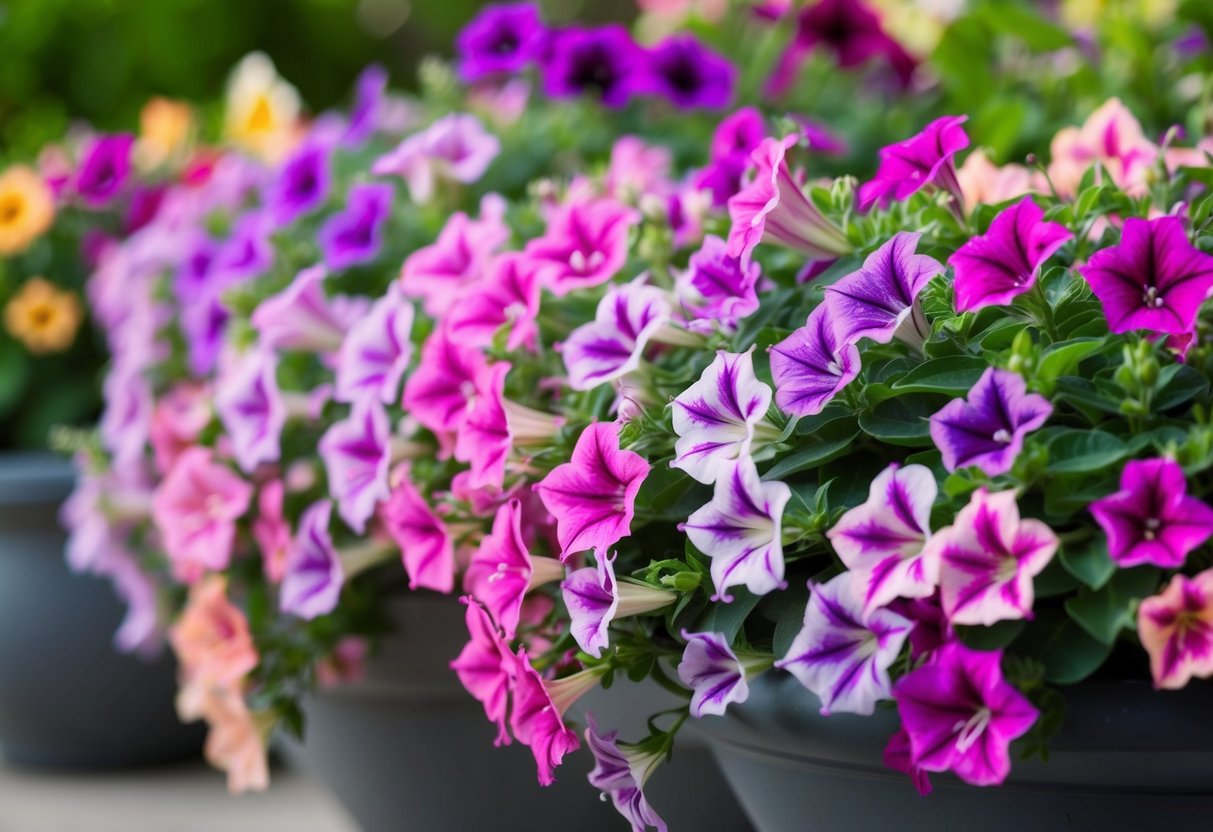
To make your petunias bloom vibrantly and enhance their beauty, focus on proper care and strategic design. Using these tips, you can ensure a colorful and eye-catching display all season.
Encouraging Vibrant Blooms
To help your petunias produce vibrant blooms, they need plenty of sunlight and nutrients. They require at least 6 hours of sunlight daily. More exposure is even better for robust flowering.
Fertilizing petunias with a higher ratio of phosphorus and potassium promotes beautiful blooms. Dilute the fertilizer to about one-fourth or half of what’s recommended to prevent nutrient overload.
Regular deadheading, or removing spent blooms, encourages new growth and keeps the plant looking neat. Remember, some varieties are self-cleaning and don’t need deadheading.
Water consistently, especially for petunias in hanging baskets, to prevent wilting.
Design and Display Tips
Petunias are quite versatile and can decorate your space in many ways. Plant them in containers or hanging baskets for flexible placement, allowing you to adjust their position for sunlight and aesthetics.
For a bold look, mix varieties with different colors and double blooms. Use them as ground cover or border plants to add fragrance and color.
Remember that some types of petunias spread more than others, so plan your garden design accordingly.
By using these creative strategies, you can create a stunning display that highlights the trumpet-shaped flowers of your petunias.
Seasonal Considerations
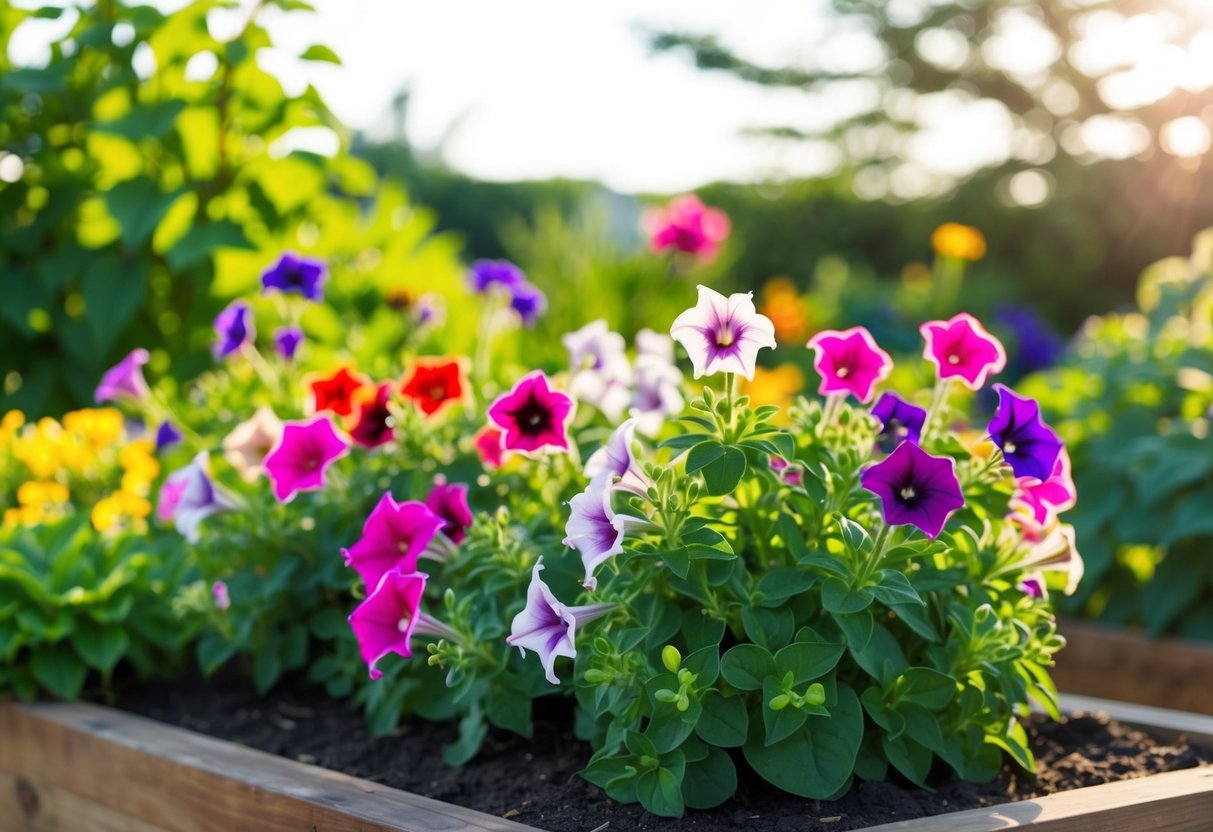
Petunias thrive in warm conditions but face challenges when temperatures drop. Understanding how to manage these changes can help you keep your petunias healthy throughout the year. During colder months, it’s essential to know how to protect them from frost and effectively care for them in winter.
Handling Frost and Temperature Changes
Petunias are sensitive to frost and need special attention when temperatures fall. To protect them, consider using coverings like frost cloths on cold nights.
If you live in a frost-prone area, you may want to grow petunias in containers, so they can be moved indoors easily.
These plants prefer full sun, which supports their fast-growing nature. The ideal temperature for petunias ranges from 60°F to 75°F.
Ensure your garden spot receives ample sunlight, even if temperatures fluctuate. Adding a layer of compost to the soil helps insulate roots and maintain moisture levels during cooler days.
Winter Care and Overwintering
In regions with mild winters, you can overwinter petunias by bringing them indoors. Place them near a bright window, where they can still enjoy full sun. If this isn’t possible, consider setting up grow lights to simulate sunlight. Keep them in a spot where temperatures remain above 55°F.
During the winter months, you should reduce watering as petunias grow slower and need less moisture. Focus on maintaining a balance to avoid root rot. Regularly check the plant’s height and trim as needed to keep it healthy. If your petunias are grown as annual flowers in harsh climates, letting them complete their lifecycle outdoors may be more practical.







